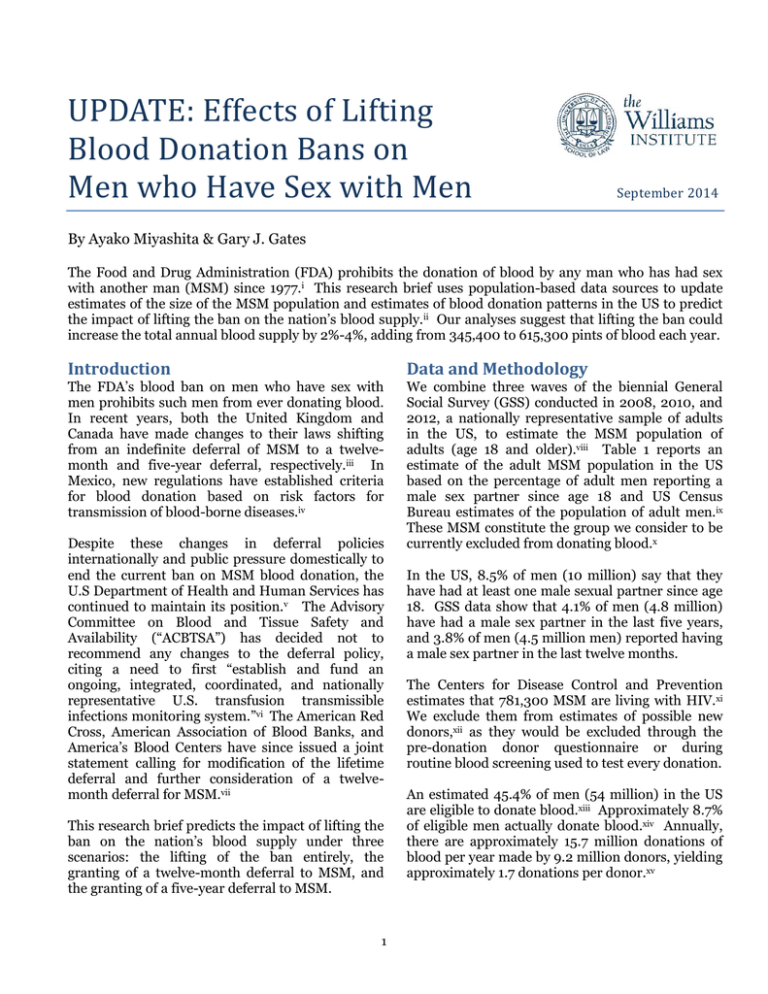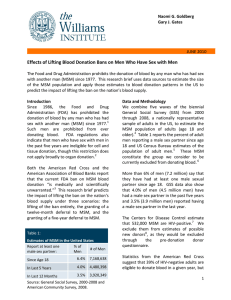UPDATE: Effects of Lifting Blood Donation Bans on
advertisement

UPDATE: Effects of Lifting Blood Donation Bans on Men who Have Sex with Men September 2014 By Ayako Miyashita & Gary J. Gates The Food and Drug Administration (FDA) prohibits the donation of blood by any man who has had sex with another man (MSM) since 1977.i This research brief uses population-based data sources to update estimates of the size of the MSM population and estimates of blood donation patterns in the US to predict the impact of lifting the ban on the nation’s blood supply.ii Our analyses suggest that lifting the ban could increase the total annual blood supply by 2%-4%, adding from 345,400 to 615,300 pints of blood each year. Introduction Data and Methodology The FDA’s blood ban on men who have sex with men prohibits such men from ever donating blood. In recent years, both the United Kingdom and Canada have made changes to their laws shifting from an indefinite deferral of MSM to a twelvemonth and five-year deferral, respectively.iii In Mexico, new regulations have established criteria for blood donation based on risk factors for transmission of blood-borne diseases.iv We combine three waves of the biennial General Social Survey (GSS) conducted in 2008, 2010, and 2012, a nationally representative sample of adults in the US, to estimate the MSM population of adults (age 18 and older).viii Table 1 reports an estimate of the adult MSM population in the US based on the percentage of adult men reporting a male sex partner since age 18 and US Census Bureau estimates of the population of adult men.ix These MSM constitute the group we consider to be currently excluded from donating blood.x Despite these changes in deferral policies internationally and public pressure domestically to end the current ban on MSM blood donation, the U.S Department of Health and Human Services has continued to maintain its position.v The Advisory Committee on Blood and Tissue Safety and Availability (“ACBTSA”) has decided not to recommend any changes to the deferral policy, citing a need to first “establish and fund an ongoing, integrated, coordinated, and nationally representative U.S. transfusion transmissible infections monitoring system.”vi The American Red Cross, American Association of Blood Banks, and America’s Blood Centers have since issued a joint statement calling for modification of the lifetime deferral and further consideration of a twelvemonth deferral for MSM.vii This research brief predicts the impact of lifting the ban on the nation’s blood supply under three scenarios: the lifting of the ban entirely, the granting of a twelve-month deferral to MSM, and the granting of a five-year deferral to MSM. 1 In the US, 8.5% of men (10 million) say that they have had at least one male sexual partner since age 18. GSS data show that 4.1% of men (4.8 million) have had a male sex partner in the last five years, and 3.8% of men (4.5 million men) reported having a male sex partner in the last twelve months. The Centers for Disease Control and Prevention estimates that 781,300 MSM are living with HIV.xi We exclude them from estimates of possible new donors,xii as they would be excluded through the pre-donation donor questionnaire or during routine blood screening used to test every donation. An estimated 45.4% of men (54 million) in the US are eligible to donate blood.xiii Approximately 8.7% of eligible men actually donate blood.xiv Annually, there are approximately 15.7 million donations of blood per year made by 9.2 million donors, yielding approximately 1.7 donations per donor.xv Table 1. Estimates of the MSM population in the United States Report at least one male sex partner: Since Age 18 In Last 5 Years In Last 12 Months % of Men 8.5% 4.1% 3.8% # of Menxvi 10,033,500 4,839,700 4,485,600 Source: General Social Survey 2008-2012 and US Census Bureau, 2013 Population Estimates. Our analyses suggest that lifting the ban could increase the total annual blood supply by 2%-4%.xvii The American Red Cross suggests that each blood donation has the potential to be used in life-saving procedures on three individuals. Our estimates suggest that lifting the blood donation ban among MSM could be used to help save the lives of more than a million people. About the authors Findings Using the assumptions described above, we estimate the number of MSM who would be newly eligible to donate blood, would likely donate, and the number of donations resulting under three scenarios. Results are shown in Table 2. Table 2. Estimates of Number of Men Who May Donate Blood Lifting of Blood Donation Ban TwelveMonth Deferral FiveYear Deferral Conclusion # Eligible to Donate # Likely to Donate # of Pints Donated 4,200,500 360,600 615,300 2,164,100 185,800 317,000 2,003,300 172,000 293,400 Ayako Miyashita is the Brian Belt HIV Law & Policy Fellow. Gary J. Gates, PhD is the Williams Distinguished Scholar and a national expert in the demographic, geographic, and economic characteristics of the LGBT population. About the Institute The Williams Institute on Sexual Orientation and Gender Identity Law and Public Policy at UCLA School of Law advances law and public policy through rigorous, independent research and scholarship, and disseminates its work through a variety of education programs and media to judges, legislators, lawyers, other policymakers and the public. If the current MSM ban were completely lifted, we estimate that an additional 360,600 men would likely donate 615,300 additional pints of blood each year. If MSM who have not had sexual contact with another man in the past twelve months were permitted to donate, we estimate that 185,800 additional men are likely to donate 317,000 additional pints of blood each year. If MSM who have not had sexual contact with another man in the past five years were permitted to donate, we estimate that 172,000 additional men would make an additional 293,400 blood donations. 2 For more information The Williams Institute, UCLA School of Law Box 951476 Los Angeles, CA 90095‐1476 (310)267‐4382 williamsinstitute@law.ucla.edu www.law.ucla.edu/williamsinstitute Citation Miyashita, A, Gates, GJ. 2014. UPDATE: Effects of Lifting the Blood Donation Ban on Men who have Sex with Men. Williams Institute, UCLA School of Law. Vaccines, Blood & Biologics. “Blood Donations from Men Who Have Sex with Other Men Questions and Answers.” U.S Food and Drug Administration Web site. http://www.fda.gov/biologicsbloodvaccines/bloodbloodpr oducts/questionsaboutblood/ucm108186.htm#policy. Accessed September 15, 2014. ii See Effects of Lifting Blood Donation Bans on Men Who Have Sex with Men. The Williams Institute. June 2010. http://williamsinstitute.law.ucla.edu/wpcontent/uploads/Gates-Goldberg-MSM-Blood-Ban-Jun2010.pdf. Accessed September 15, 2014. iii NHS Blood and Transplant. “Deferral of Blood Donation from Men who have Sex with Men from Blood Donation FAQs.” National Health Service Web site. http://www.nhsbt.nhs.uk/news-and-media/newsarchive/news_2011_11_01_faqs.asp. Accessed September 15, 2014;. Changes to blood donor guidelines. Canadian Blood Services Web site. http://www.blood.ca/CentreApps/Internet/UW_V502_M ainEngine.nsf/page/MSM?OpenDocument. Accessed September 15, 2014. iv Noticias. “Celebra Conapred entrada en vigor de norma de donación de sangre, libre de discriminación.” Consejo Nacional para Prevenir Discriminación (CONAPRED) Web site. http://www.conapred.org.mx/index.php?contenido=notic ias&id=3334&id_opcion=108&op=214. Accessed September 15, 2014. v Cohen, I Glenn, JD, et. al. Reconsideration of the Lifetime Ban on Blood Donation by Men Who Have Sex with Men. JAMA. July 23/30, 2014; Volume 312, Number 4, Pages 337-38. vi Forty-fourth Meeting of the Advisory Committee on Blood & Tissue Safety & Availability (ACBTSA), December 4-5, 2013. Department of Health and Human Services Web site. http://www.hhs.gov/ash/bloodsafety/advisorycommittee/ recommendations/dec2013-recommendations.pdf. Accessed September 15, 2014. vii Joint Statement Regarding National Gay Blood Drive. June 27, 2014. American Red Cross Web site. http://www.redcross.org/news/press-release/StatementRegarding-National-Gay-Blood-Drive. Accessed September 15, 2014. viii Data from General Social Surveys conducted between 2008 and 2012 were combined to yield estimates of the number of men who report same-sex partners since age 18. This is based on the following question—“Again, thinking about the time since your 18th birthday, (including the past 12 months) how many male partners have you ever had sex with?” Any man indicating one or more male partners was counted as an MSM. Five-year and twelve-month estimates are based on the following question—“Have your sex partners in the last 12 months (five years) been exclusively male, both male and female, or exclusively female?” Male respondents who indicated “exclusively male” or “both male and female” were considered MSM in this report. Analyses were conducted using the Survey Document and Analysis (SDA) website http://sda.berkeley.edu/sdaweb/analysis/?dataset=gss12. Accessed September 15, 2014. Table PEPAGESEX - Annual Estimates of the Resident Population for Selected Age Groups by Sex for the United States, States, Counties, and Puerto Rico Commonwealth and Municipios: April 1, 2010 to July 1, 2013. US Census Bureau Web site. http://factfinder2.census.gov/faces/tableservices/jsf/page s/productview.xhtml?src=bkmk. Accessed September 15, 2014. x Current FDA policy excludes any man who reports having a male sex partner since 1977 from donating blood. We must assume that all men who report at least one male sex partner since age 18 are currently ineligible to donate since we cannot separately identify men whose male sex partnerships occurred before 1977. As a result, our estimates of newly eligible donors may include some men who are already eligible. This upward bias is likely quite small as we are possibly misclassifying only men who are aged 55 or older who had a sex partner before 1977 but not since. xi Monitoring Selected HIV Prevention and Care Objectives by Using HIV Surveillance Data—United States and 6 U.S. Dependent Areas—2010. HIV Surveillance Report, Volume 17, Number 3, Page 22. Center for Disease Control and Prevention Web site. http://www.cdc.gov/hiv/pdf/statistics_2010_HIV_Survei llance_Report_vol_17_no_3.pdf#page=22. Accessed September 15, 2014. xii We do not have data that allows us to estimate the number of HIV-positive MSM who have had sex with a man in the last twelve months or five years. As such, we take a conservative approach and assume that all HIVpositive MSM have had recent same-sex sexual activity and subtract the total number of HIV-positive MSM from each of the three groups (had sex with a man since age 18, had sex with a man in the last year, and had sex with a man in the last five years). xiii James, AB, Hillyer, CD, Shaz, BH. 2012. Demographic differences in estimated blood donor eligibility prevalence in the United States. Transfusion 52(6):1050-1061, Table 4. xiv The American Red Cross estimates 9.3 million donors per year of which 50% are men. The portion of eligible men who donate is calculated by dividing the number of male donors by the number of men that are eligible to donate in the US. xv Blood Facts and Statistics. American Red Cross Web site. http://www.redcrossblood.org/learn-aboutblood/blood-facts-and-statistics. Accessed September 15, 2014. xvixviFigures are rounded off to the nearest hundred. xvii The percentage increase in annual blood supply is based on the assumption that there are 15.7 million blood donations per year (see Blood Facts and Statistics. American Red Cross Web site. http://www.redcrossblood.org/learn-about-blood/bloodfacts-and-statistics. Accessed September 15, 2014) and considers the percentage increase for the scenarios provided in Table 2. i ix 3









